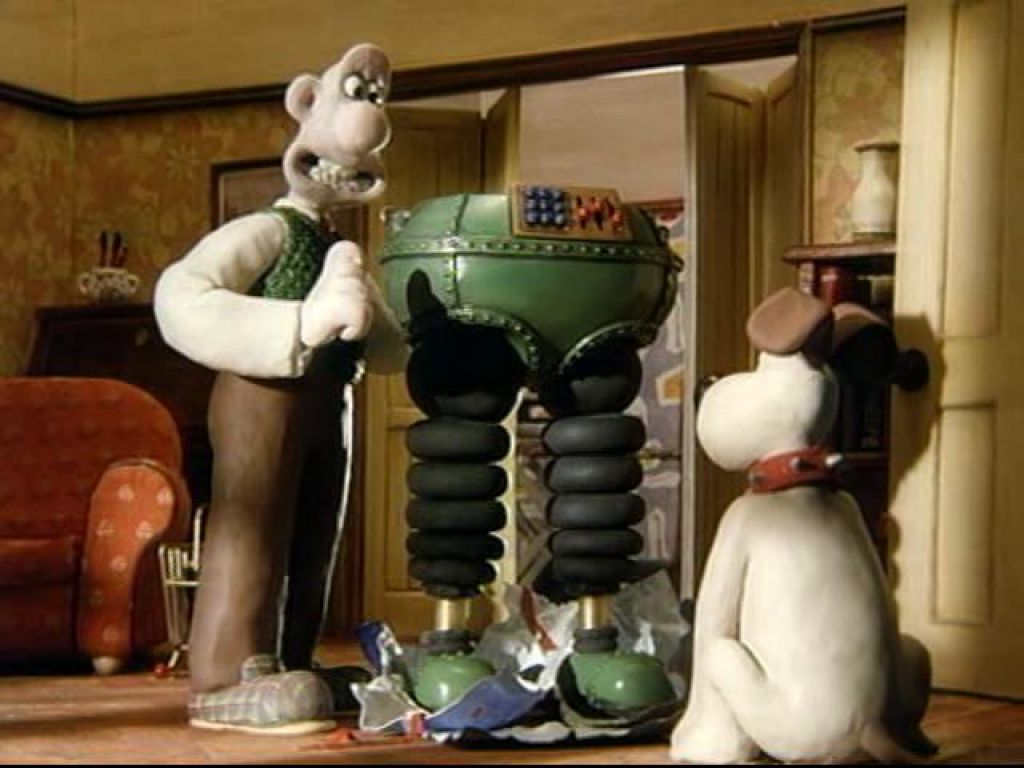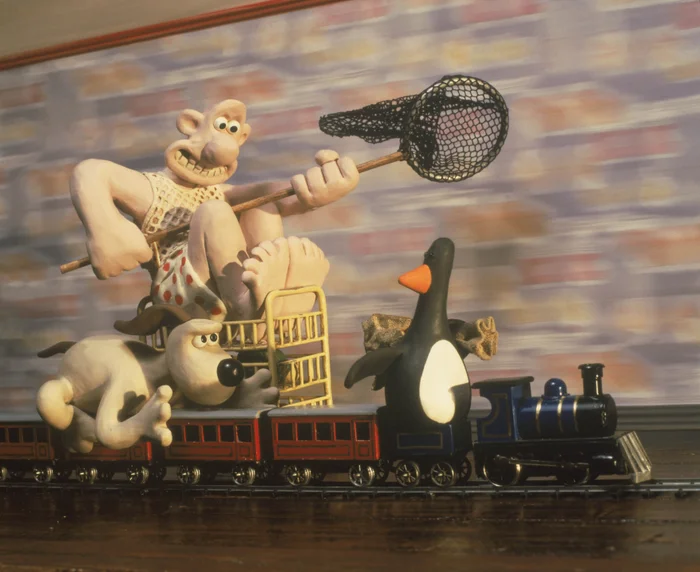Somewhere in Northern England, the doorbell rings; a visitor has come to view the room that’s to let. All seems well until suddenly he stops at the foot of the stairs, turns sharply and stares at one of the inhabitants, his ink-black eyes expressionless. All at once we know: this penguin can’t be trusted.
The penguin is Feathers McGraw, the flippered fiend who terrorizes Wallace, a bumbling, cheese-obsessed inventor and Gromit, his long-suffering dog, in The Wrong Trousers. The calamities begin on Gromit’s birthday. When the morning post arrives, he sorts though it and is rewarded with the most saccharine birthday card imaginable. It’s a wonder the tinny music it plays doesn’t drive him to despair. His presents from Wallace are a studded collar and lead, and something hulking and mechanical which lurches toward the poor dog, backing him into a corner as he shrinks away in terror. Once the wrapping paper is off, it’s revealed to be a pair of robotic Techno Trousers: cumbersome, overengineered—they’re ex-NASA, though what use the agency could have had for them is unclear—and very Wallace. Gromit is sceptical.
Wallace’s funds are low, so he decides to rent the spare room out; Feathers arrives the same day. The penguin quickly usurps Gromit’s place, commandeering his bedroom, taking over his daily ritual of bringing Wallace the paper and torturing the dog with Hammond organ music day and night. Making Gromit miserable isn’t Feathers’ only goal. He has other, larcenous ambitions, involving Wallace, the Techno Trousers and the diamond on display at the local museum.
The Wrong Trousers was Wallace and Gromit’s second outing. They’d made their debut three years before in A Grand Day Out, which began as animator Nick Park’s thesis film at the National Film and Television School—Aardman offered to help him finish it—and ended up netting him an Academy Award nomination for best animated short film. (He lost to Lip Synch: Creature Comforts, another Aardman film directed by…Nick Park.)
Co-written by Park (who also directed) and Bob Baker, with contributions by Brian Sibley, The Wrong Trousers’ script is tighter and wittier. Sight gags abound. Wallace’s safe is in the dining room, behind a painting of piggy bank; he opens it to retrieve an actual piggy bank, which contains his savings. Some jokes are so subtle you might miss them on first viewing: Gromit has a dart board hanging on the back of his bedroom door, but the many, many holes on the door itself suggest he’s a slow learner.
The film is full of loving details because it is itself a labour of love. It can take an animator a day to film the equivalent of around a second of film. And for decades, Aardman has only used a specific kind of clay because it’s easy to mould and doesn’t melt under studio lights. (The closure of the only company that makes it alarmed fans.) Unlike its predecessor, The Wrong Trousers was made completely with the studio’s resources and it shows in the more sophisticated character design, more ambitious sets and staging and Julian Nott’s bigger, brassier score. It’s a film so tactile and personal the filmmakers’ fingerprints are quite literally on display.
Gromit could only have been created by hand. Park originally meant him to be a cat but found it was easier to fashion a dog out of clay. Although he never speaks, Gromit is one of most expressive characters in all animation. Just the slightest shift of his brow conveys everything from affection to exasperation to sheer bewilderment. He is a sophisticated dog, who knits, reads extensively (he enjoys philosophy and engineering), listens to classical music and, if the racquet in his room is any indication, plays tennis. But he is also the universe’s chew toy and he knows it. While investigating Feathers’ schemes, Gromit is forced to hide and ends up entangled in one of Wallace’s inventions just as it’s triggered. He looks mournfully at the camera before getting dragged in. Bestowing him with a collar, Wallace tells him, “You look like somebody owns you now.” But the truth is Wallace is as much Gromit’s human as the other way around.
Like Jeeves before him, Gromit is the cloud cuckoolander’s minder, steering his master away from life’s potholes when he can. But while the gentleman’s gentleman sometimes extracted a reward for his efforts (Bertie’s gauche white mess jacket, for instance), Gromit never does. That’s partly why Wallace’s neglect of him in The Wrong Trousers is so painful. The dog is selfless.
Park takes equal care with the rest of his cast. Wallace is good-natured but careless, capable of quixotic flights of imagination but quite oblivious to his dependence on Gromit. Look at the contraption he’s built his morning routine around. It’s engineered to get him out of bed, dressed and fed, yet he still relies on Gromit to pull a lever to start it. It simply doesn’t occur to him to do otherwise. He would be insufferable except for his innate silliness and the warmth of Peter Sallis’ vocal performance.
Feathers McGraw takes Wallace’s measure instantly. Silent and sinister, much of his menace lies in his stillness. He rarely blinks. When he moves, his gestures are measured, or so abrupt they throw others off balance. An avian Moriarty is inherently funny—who would suspect a penguin of dastardly crimes?—but Feathers takes his business very seriously, dragging Wallace and Gromit into a Hitchcockian thriller even more perilous than their trip to the moon. It’s no wonder he remains the series’ most memorable villain and, so far, the only one who’s been accorded a repeat performance (in 2024’s Wallace & Gromit: Vengeance Most Fowl).
Feathers sets about making Wallace and Gromit’s world as inhospitable as possible, but it still feels wonderfully lived in. Everything in their terrace house, which hangs suspended somewhere between the 1950s and 60s, has character: a pink toaster decorated with blue and white flowers; the pastel floral wallpaper; and especially the marrow framed and mounted on the dining room wall. (Many of the items were inspired by things Park remembered seeing in his grandmother’s home.) Their world is also peculiarly English, although pinning Wallaby Street down on a map isn’t easy. Careful inspection of the morning post suggests it’s in Wigan, but Wallace’s accent and his beloved Wensleydale cheese are from West and North Yorkshire respectively and Park himself grew up in Lancashire. The general effect is whimsical and nostalgic, give or take a homicidal penguin.
The Wrong Trousers set the template for all subsequent Wallace and Gromit adventures, establishing a blend of comedy and suspense that’s become the series’ trademark. It won Park his second Oscar for best animated short and rightly so. In a world which increasingly favours generic simulacrums of art over true creative expression, Wallace and Gromit is an antidote to such cynicism, a celebration of imagination and joy. That there are so few instalments in the series—just four shorts and two features across 34 years—makes each one even more precious.



Leave a Reply